This particular tree was partially uprooted by the hurricane and extended well out into the water of the storm-water drainage canal. In April of 2018, A pair interacted on the partially submerged branches of the fallen tree:

Their nest was placed rather precariously over the water on the horizontal trunk:

The next day, an adult Yellow-crowned Night-Heron was sitting low on the nest:

I subsequently photographed eggs in the nest, but had to fly back out to Illinois to close the sale of our condo. A few weeks later I returned to Florida and found only a single immature heron in the rookery. Here it was in early July, 2018:
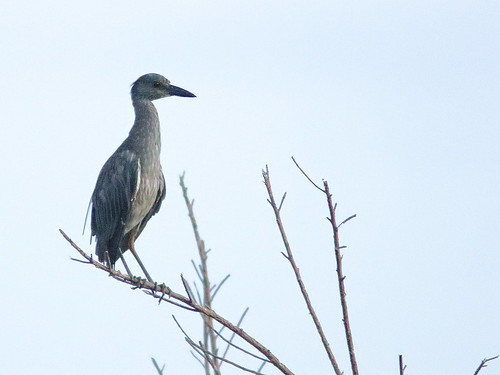
In August, 2018 it had begun to molt into adult plumage:

I cannot say for sure that it is the same bird, but this is a sub-adult roosting very close to the nest site in the condemned tree, marked for removal (October 18, 2018):

After the cutting, only one pair out of the several night-herons which had gathered in the damaged area stayed on and built a nest, as documented in my earlier post. A single immature bird remained to roost next to the stump of the only tree which held a nest in the previous spring. Was it the same bird? Did it hatch from the nest in the missing tree? Here it is in December, 2018. Note that its head is streaked, a feature which may persist into its second year of life:

For weeks, it was the only immature bird in the rookery, seen here on February 12, 2019:

As spring approaches, adults in breeding condition develop head and back (occipital and scapular) plumes. Their heads turn clear yellow and their legs become red:


This takes us up to the present. Inexplicably, on March 9, 2019, the pair which was building the nest (as documented in my earlier post) simply disappeared. Suddenly the rookery was abandoned-- almost. The sub-adult was reliably present every day, roosting next to the site formerly occupied by the nest tree. Then it also disappeared for a few days and I concluded that the rookery had indeed been abandoned.
However, on April 16, the (same?) sub-adult reappeared. This time it was accompanied by an adult in bright breeding plumage which performed a courtship display!
Note the absence of head plumes on the female:

The male has full plumes and red legs:
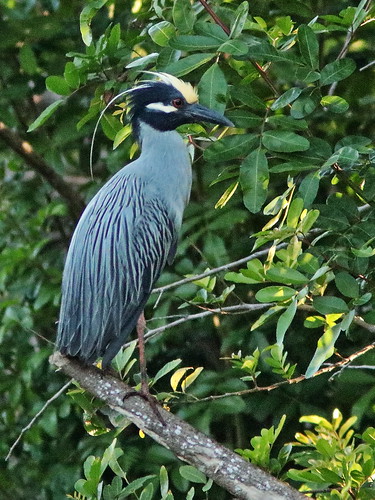
He displayed to the somber female, and also started carrying in nesting material to an area of the rookery which was left undamaged:

As a bonus, a bonded pair of Green Herons appeared. Although I failed to obtain a photo of the action, a third one showed up and was chased away. Luckily, it landed in a small tree right next to me. This is the interloper. Note yellow legs as opposed to the members of the pair, which were in breeding plumage and had red legs. The emerging leaves of the Mahogany tree enhanced this portrait:

Since I plan to be away for week after Easter, I have prepared this in advance. A few other images from the past few days--
Horned Bladderwort emerged in the lakeside marsh. This is a carnivorous plant which traps small insects and other tiny organisms, digesting them in its "bladders," underwater tubes which snap open and suck in the prey. This allows it to survive where the environment is poor in nutrition. Its foliage and seeds are poisonous:

Interestingly, another species of bladderwort, Little Floating Bladderwort, occupied the same patch of shallow open water:

The sky was pink before sunrise in the ATV-scarred north Wet Prairie:

A Solitary Sandpiper cast a nice reflection as it foraged in the tracks left by the "wreckreational vehicles:"
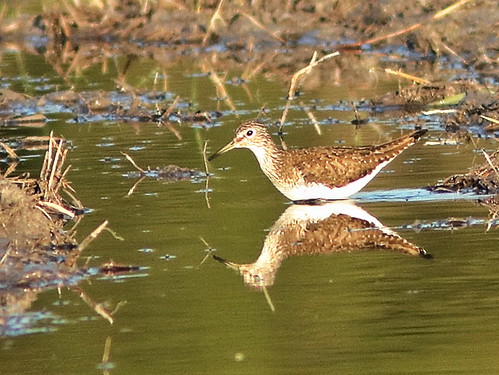
At a high spot in the wetlands, the pumpkin-like fruit of a wild exotic Surinam Cherry brightened the scene:
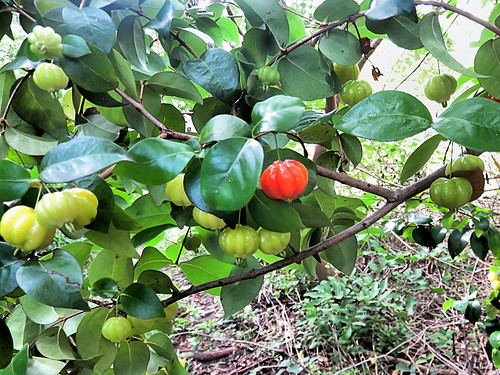
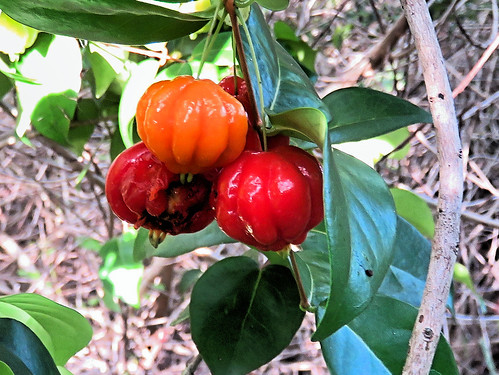
= = = = = = = = = = = = = = =
Linking to Misty's CAMERA CRITTERS,
Linking to Eileen's SATURDAY'S CRITTERS,
Linking to SKYWATCH FRIDAY by Yogi, Sylvia and Sandy
Linking to WEEKEND REFLECTIONS by James
Linking to BirdD'Pot by Anni
Linking to Our World Tuesday by Lady Fi
Linking to Wild Bird Wednesday by Stewart
Linking to Wordless Wednesday (on Tuesday) by NC Sue
Linking to ALL SEASONS by Jesh
________________________________________________
Please visit the links to all these memes to see some excellent photos on display
________________________________________________
I've never seen anything nibbling on those pumpkin fruit. Be nice for one invasive species to have a good side.
ReplyDeleteInteresting to see the ebb and flow of the heron population. Pretty sky shot. Have a great weekend!
ReplyDeleteHello, it is neat seeing the YC Night Heron rookery. Your photos are awesome. Pretty flowers and sky shot. Great post. Happy weekend!
ReplyDeleteWhat amazing poses from those Night Herons! You take the best photos!
ReplyDeleteGorgeous birds! I hope they thrive. Nature has been taking a beating.
ReplyDeleteI love seeing the display plumage of the yellow crowned night heron! HOPE YOU'RE FEELING BETTER TODAY.
ReplyDeleteOnce again, thanks for stopping by I'd Rather B Birdin' and linking in with us birders. I appreciate your loyalty and sharing.
I have to tell you this is the best story I've read in a long time - beautiful images too!
ReplyDeleteAren't they beautiful! Wonderful post.
ReplyDeleteThanks for sharing at https://image-in-ing.blogspot.com/2019/04/in-memoriam.html
Such beautiful birds. You are a wonderful photographer.
ReplyDeleteWorth a Thousand Words
Interesting post - it would be great to be able to tell birds apart at times without having to colour band them! If this is a story of the same bird, the its a determined bird indeed!
ReplyDeleteCheers - Stewart M - Melbourne
These birds are so elegant looking! The males even more than the females:):) Am glad I'm not a bird. To have your nest is such an off balance place would be a constant hazard to me! Many thanks for this post, Ken! Only ... you forgot to send All Seasons a thumbnail image! Please, could you send it before Friday noon, Thanks so much! Junieper/Jesh
ReplyDeleteBeautiful photos of birds. I also enjoyed seeing the picture of their habitat. Such a lovely place.
ReplyDeleteMy post features tulip fields in Mt. Vernon, Washington.
Many thanks for following up with your thumbnail, Ken have a great week:)
ReplyDeleteI have never seen that kind of heron before!
ReplyDelete